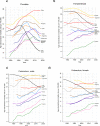An updated profile of the cancer burden, patterns and trends in Latin America and the Caribbean
- PMID: 36189115
- PMCID: PMC9483035
- DOI: 10.1016/j.lana.2022.100294
An updated profile of the cancer burden, patterns and trends in Latin America and the Caribbean
Abstract
Background: Cancer is a leading cause of disease and death in Latin America and the Caribbean (LAC). Contemporary data on the cancer burden aims to inform effective cancer policies; this article provides an update and benchmarking of national cancer incidence and mortality estimates for the year 2020, alongside recent mortality trends in the region.
Methods: The number of new cancer cases and deaths were extracted from the GLOBOCAN 2020 database developed by the International Agency for Research on Cancer (IARC), and mortality data over time from IARC's cancer mortality database, New cancer cases, deaths and corresponding age-standardized rates per 100,000 person-years are presented. Random fluctuations in mortality trends by country, sex and cancer site were smoothed using LOWESS regression.
Findings: An estimated total of 1.5 million new cancer cases and 700,000 deaths occur annually in LAC, with corresponding incidence and mortality rates of 186.5 and 86.6 per 100,000. The most common cancers in 2020 were prostate (15%), breast (14%), colorectal (9%), lung (7%) and stomach (5%). Lung cancer remained the leading cause of cancer death (12%), though rates varied substantially between countries. The mortality trends of infectious-related cancers tended to decline in most countries, while rates of cancer types linked to westernization were mainly increasing. Assuming rates remain unchanged, the cancer burden in LAC will increase by 67% reaching 2.4 million new cases annually by 2040.
Interpretation: The cancer patterns reflect important underlying sociodemographic changes occurring over the last decades. With an increasing burden anticipated over the next decades in this region, there is a need to plan oncological service provision accordingly.
Funding: No external funds received.
Keywords: Cancer; Epidemiology; Global health; Neoplasms; Public health surveillance.
© 2022 World Health Organization.
Conflict of interest statement
EdV declared payment or honoraria by AMGEN for presentation on socioeconomic inequalities in Colombia presenting results of projects not related to the industry. All other authors declare that they have no competing interests.
Figures







References
-
- Comisión Económica para América Latina y el Caribe (CEPAL) 2020. Anuario Estadístico de América Latina y el Caribe.https://www.cepal.org/es/publicaciones/46739-anuario-estadistico-america... (2021 28/09/2021). Available from:
-
- Bray F, Laversanne M, Weiderpass E, Soerjomataram I. The ever-increasing importance of cancer as a leading cause of premature death worldwide. Cancer. 2021;127(16):3029–3030. - PubMed
-
- Ferlay J, Ervik M, Lam F, et al. International Agency for Research on Cancer; France: 2021. Global Cancer Observatory: Cancer Tomorrow Lyon.https://gco.iarc.fr/tomorrow/en Available from:
-
- WHO Mortality database [Internet]. 2021 [cited 12/10/2021]. Available from: https://www.who.int/data/data-collection-tools/who-mortality-database.
-
- Bray F, Piñeros M. Cancer patterns, trends and projections in Latin America and the Caribbean: a global context. Salud Publica Mex. 2016;58(2):104–117. - PubMed
Grants and funding
LinkOut - more resources
Full Text Sources

